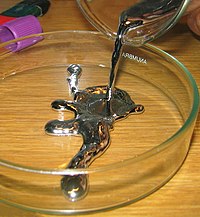
Photo from wikipedia
The electrocatalytic nitrate reduction reaction (NO3-RR) to ammonia (NH3) under ambient conditions not only has the benefit of lowering energy consumption, but also helps remove nitrate contamination. Inspired by the… Click to show full abstract
The electrocatalytic nitrate reduction reaction (NO3-RR) to ammonia (NH3) under ambient conditions not only has the benefit of lowering energy consumption, but also helps remove nitrate contamination. Inspired by the unique structure of nitrate/nitrite reductase with the active spheroproteins encapsulated by larger enzymes, herein, we develop an in situ synthetic strategy for the construction of metal cluster-conductive metal-organic framework (MOF) composite electrocatalysts. The metallic Cu clusters are filled into the mesopores of a conductive copper-based MOF (i.e., CuHHTP); meanwhile, CuHHTP with a porous structure provides an internal environment to limit the growth of metallic Cu clusters with an ultrasmall size (i.e., 1.5 ± 0.2 nm) and restrains their aggregation. The obtained Cu@CuHHTP exhibits superb performance for NO3-RR. In a neutral electrolyte with 500 ppm NO3-, Cu@CuHHTP shows a high NO3- conversion of 85.81% and a selectivity for NH3 of 96.84%. 15N isotope labeling experiments confirm that the formation of NH3 originates from the process of NO3-RR. Theoretical calculations confirm that Cu clusters are the active sites in the composite electrocatalysts, in which the proper d-band center and the "accept-donate" mechanism in charge transfer are the key factors for the improvement of the electrocatalytic performance.
Journal Title: ACS applied materials & interfaces
Year Published: 2022
Link to full text (if available)
Share on Social Media: Sign Up to like & get
recommendations!